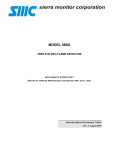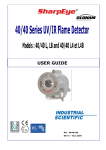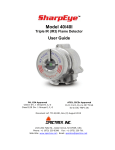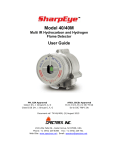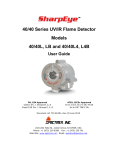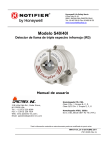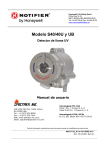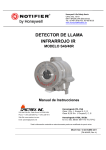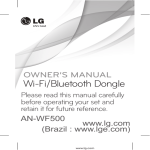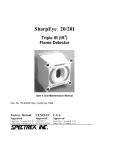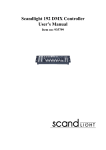Download SharpEye 20 User guide
Transcript
USER GUIDE Ref : NP40IGB REV A – Nov 2009 GAS DETECTION We are delighted that you have chosen an INDUSTRIAL SCIENTIFIC instrument and would like to thank you for your choice. We have taken all the necessary measures to ensure that your instrument provides total satisfaction. Now it is important to read this document carefully. EXTENT OF RE SPONSIB ILIT Y * INDUSTRIAL SCIENTIFIC declines its responsibility towards any person for material damage, physical injury or death resulting wholly or partly from inappropriate use, installation or storage of its equipment resulting from failure to observe instructions and warnings and/or standards and regulations in force. * INDUSTRIAL SCIENTIFIC neither supports nor authorises any company, physical or moral person to assume responsibility on behalf of INDUSTRIAL SCIENTIFIC , even if it is involved in the sale of INDUSTRIAL SCIENTIFIC products. * INDUSTRIAL SCIENTIFIC cannot be held responsible for direct or indirect damage or be required to pay direct or indirect compensation resulting fro m the sale or use of any of its products IF THESE PRODUCTS HAVE NOT BEEN DEFINED AND CHOSEN BY INDUSTRIAL SCIENTIFIC FOR THEIR SPECIFIC USE. CLAUSES CONCERNING PROPERTY * Drawings, plans, specifications and information included in this document contain confidential information that is the property of INDUSTRIAL SCIENTIFIC * None of this information may be reproduced, copied, divulged or translated, by physical, electronic or any other means, nor used as the basis for the manufacture or sale of INDUSTRIAL SCIENTIFIC equipment or for any other reasons without prior consent from INDUSTRIAL SCIENTIFIC WARNIN GS * This document is not contractually binding. In the interests of its customers, INDUSTRIAL SCIENTIFIC reserves to modify the technical specifications of its equipment without notice, in order to improve its performance. * READ THIS MANUAL CAREFULLY BEFORE FIRST USE OF THE EQUIPMENT: this manual must be read by any person who is or will be responsible for using, maintaining or repairing this equipment. * This equipment will only provide the announced performance levels if it is used, maintained and repaired according to INDUSTRIAL SCIENTIFIC directives, by INDUSTRIAL SCIENTIFIC personnel or by personnel approved by INDUSTRIAL SCIENTIFIC GUARANTEE 5 years guarantee in normal conditions of use on parts and technical labour, return in our workshops, excluding consumables (sensors, filters, etc.) 3 About this Guide This guide describes the SharpEye Model 40/40I Triple IR (IR3) Flame Detector and its features and provides instructions on how to install, operate and maintain the detector. This guide includes the following chapters and appendixes: • Chapter 1, Introduction, provides a general overview of the product, principles of operation, and performance considerations. • Chapter 2, Installing the Detector, describes how to install the detector including preparations before installation, wiring and mode settings. • Chapter 3, Operating the Detector, describes how to power-up and test the detector. The chapter also lists safety precautions you should take when operating the detector. • Chapter 4, Maintenance and troubleshooting, describes basic maintenance procedures, and troubleshooting and support procedures. • Appendix A, Technical Specifications : Lists the detectors technical specifications. • Appendix B , Wiring Instructions , lists the wiring instructions for connecting the detector and also provides examples of typical wiring configurations. • Appendix C, RS-485 Communication Network , provides an overview of the RS-485 communications network. • Appendix D, Accessories, describes the accessories available for the detector. • Appendix E, SIL-2 Features, describes the special conditions to comply with the requirements of EN 61508 for SIL 2 according to TUV. 4 Abbreviations and Acronyms Abbreviation Meaning ATEX Atmosphere Explosives AWG BIT American Wire Gauge Built In Test EMC Electromagnetic Compatibility EOL End of Line FOV Field of View HART Highway Addressable Remote Transducer-communication protocol IAD Immune at Any Distance IECEx IPA International Electrotechnical Commission Explosion Isopropyl Alcohol IR Infrared JP4 Jet Fuel Latching Refers to relays remaining in the ON state even after the ON condition has been removed LED Light Emitting Diode LPG mA Liquefied Petroleum Gas MilliAmps (0.001 amps) MODBUS Master-slave messaging structure N.C. Normally Closed N.O. Normally Open N/A Not Applicable NFPA National Fire Protection Association NPT SIL National Pipe Thread Safety Integrity Level UNC Unified Coarse Thread VAC Volts Alternating Current 5 Table of Contents About this Guide ........................................................................................................................ 4 Abbreviations and Acronyms ...................................................................................................... 5 1 INTRODUCTION.................................................................................................................9 1.1 Overview ....................................................................................................................... 9 1.2 Model and Types ............................................................................................................ 9 1.3 Features and Benefits .................................................................................................... 11 1.4 Principles of Operation.................................................................................................. 11 1.4.1 Hydrocarbon Fire Detection ................................................................................... 11 1.4.2 Heated Optics........................................................................................................ 11 1.4.3 HART Protocol ..................................................................................................... 12 1.4.4 RS-485 Modbus .................................................................................................... 12 1.4.5 Product Certification .............................................................................................. 12 1.5 Performance Considerations .......................................................................................... 13 1.5.1 Detection Sensitivity .............................................................................................. 13 1.5.2 Cone of Vision ...................................................................................................... 14 1.5.3 False Alarms Prevention ........................................................................................ 15 1.5.4 Visual Indicators ................................................................................................... 16 1.5.5 Output Signals ....................................................................................................... 17 1.5.6 Detector Status ...................................................................................................... 17 1.5.7 Auxiliary Relay as End-of-Line Resistor ................................................................. 18 1.6 Internal Detector Tests .................................................................................................. 19 1.6.1 Continuous Feature Test......................................................................................... 19 1.6.2 Built-In-Test (BIT) ................................................................................................ 19 2 INSTALLING THE DETECTOR.......................................................................................21 2.1 General Guidelines ....................................................................................................... 21 2.2 Unpacking the Product.................................................................................................. 22 2.2.1 Checking the Product Type .................................................................................... 22 2.3 Required Tools ............................................................................................................. 22 2.4 Certification Instructions ............................................................................................... 23 2.5 Installation Cables ........................................................................................................ 23 2.5.1 Conduit Installation ............................................................................................... 23 2.6 Installing the Tilt Mount (part no. 40/40-001) ................................................................. 24 2.6.1 Tilt Mount Specifications ....................................................................................... 25 2.6.2 Tilt Mount Assembly ............................................................................................. 25 2.7 Connecting the Detector ................................................................................................ 27 2.7.1 Verifying the Detector Wiring ................................................................................ 28 2.8 Configuring your Detector............................................................................................. 29 2.8.1 Sensitivity............................................................................................................. 29 2.8.2 Alarm Delay.......................................................................................................... 30 2.8.3 Address Set-up...................................................................................................... 30 2.8.4 Function Set-up ..................................................................................................... 30 2.8.5 Heated Optics........................................................................................................ 31 6 3 OPERATING THE DETECTOR .......................................................................................31 3.1 Powering Up ................................................................................................................ 31 3.2 Safety Precautions ........................................................................................................ 31 3.2.1 Default Functions Settings ..................................................................................... 32 3.3 Testing Procedures........................................................................................................ 32 3.3.1 Automatic BIT Test............................................................................................... 33 3.3.2 Manual BIT Test ................................................................................................... 33 3.3.3 Testing with Fire Simulator Model 20/20-310 ......................................................... 33 4 MAINTENANCE AND TROUBLESHOOTING................................................................34 4.1 Maintenance................................................................................................................. 34 4.1.1 General Procedures................................................................................................ 34 4.1.2 Periodic Procedures............................................................................................... 34 4.1.3 Keeping Maintenance Records ............................................................................... 35 4.2 Troubleshooting............................................................................................................ 35 Appendices ................................................................................................................................36 A Technical Specifications ......................................................................................................37 B Wiring Instructions .............................................................................................................40 C RS-485 Communication Network........................................................................................43 D Accessories..........................................................................................................................44 E SIL-2 Features ....................................................................................................................48 7 List of Figures Figure 1: Horizontal Field of View ................................................................................................................................. 14 Figure 2: Vertical Field of View...................................................................................................................................... 15 Figure 3: Indication LED: Indication LED .................................................................................................................... 16 Figure 4: Detector with Tilt Mount................................................................................................................................. 24 Figure 5: Tilt Mount Assembly ........................................................................................................................................ 25 Figure 6: Tilt Mount Assembly (dimensions in mm and inches)............................................................................... 26 Figure 7: Detector with Cover Removed........................................................................................................................ 27 Figure 8: Wiring Terminals .............................................................................................................................................. 41 Figure 9: Typical Wiring For 4 Wire Controllers (Using Option 1 or 2 Wiring).................................................... 42 Figure 10: 0-20mA Wiring (Sink) 4-Wire Connection................................................................................................ 42 Figure 11: 0-20mA Wiring (Source) 3-Wire Connection............................................................................................ 43 Figure 12: RS-485 Networking........................................................................................................................................ 43 Figure 13: SharpEye IR3 Long Range Fire Simulator 20/20-310 ............................................................................. 44 Figure 14: 40/40I IR3 Detector Target Point ................................................................................................................. 45 Figure 15: Tilt Mount ........................................................................................................................................................ 46 Figure 16: Weather Protection ......................................................................................................................................... 47 Figure 17: Laser Detection Coverage Pointer ............................................................................................................... 47 Figure 18: Air Shield ......................................................................................................................................................... 48 List of Tables Table 1: Wiring Options.................................................................................................................................................... 10 Table 2: Sensitivity Range Levels ................................................................................................................................... 13 Table 3: Fuel Sensitivity Ranges ..................................................................................................................................... 14 Table 4: Immunity to False Alarm Sources ................................................................................................................... 15 Table 5: Welding Immunity Distance............................................................................................................................. 16 Table 6: LED Indications.................................................................................................................................................. 16 Table 7: Available Output Types..................................................................................................................................... 17 Table 8: Detector Status.................................................................................................................................................... 17 Table 9: Output Signals versus Detector State.............................................................................................................. 18 Table 10: Results of a Successful BIT ............................................................................................................................ 20 Table 11: Results of an Unsuccessful BIT ..................................................................................................................... 20 Table 12: Results of a Successful Manual BIT ............................................................................................................. 21 Table 13: Results of an Unsuccessful Manual BIT ...................................................................................................... 21 Table 14: Tools ................................................................................................................................................................... 22 Table 15: USA Version ..................................................................................................................................................... 25 Table 16: European Version............................................................................................................................................. 25 Table 17: Model 40/40I Wiring Options........................................................................................................................ 28 Table 18: Sensitivity Settings........................................................................................................................................... 29 Table 19: Functions............................................................................................................................................................ 30 Table 20: Default Function Values.................................................................................................................................. 32 Table 21: Results of Successful Fire Simulator Test.................................................................................................... 33 Table 22: Troubleshooting Table..................................................................................................................................... 35 Table 23: Contact Ratings................................................................................................................................................. 37 Table 24: 20 mA Current Output..................................................................................................................................... 38 Table 25: Maximum DC resistance at 68°F (20ºC) for copper wire .......................................................................... 40 Table 26: Wiring length in feet (meter) .......................................................................................................................... 41 Table 27: Wiring Connections......................................................................................................................................... 42 Table 28: Sensitivity Ranges ............................................................................................................................................ 45 8 1 INTRODUCTION 1.1 Overview The SharpEye 40/40I is a flame detector that utilizes improved IR3 technology to provide state-of-the-art fire protection. The 40/40I uses patented digital signal processing to analyze the spectral and dynamic characteristics of the infrared radiation, to identify fire events with exceptional sensitivity and extreme immunity to false alarms. All 40/40 series detectors include a heated optical window for improved performance in icing, snow and condensation conditions. Detection performance can be easily adapted to all environments, applications and requirements, by changing the detector’s configuration parameters. Adjusting these parameters, as well and performing other maintenance and monitoring tasks, is possible by means of RS485-based Modbus communication or HART communication (in models with 0-20mA output). The detector enclosure is ATEX certified EExd flameproof with an integral, segregated, rear, EExe terminal compartment (avoiding exposure of the sensors and electronics to surrounding environment). Hence the combined approval EExde IIB + H2 T5 (75°C) or T4 (85°C). The SharpEye 40/40 detectors are designed to operate as a stand-alone unit directly connected to an alarm system or an automatic fire extinguishing system. The detector can also be a part of a more complex system, where many detectors and other devices are integrated through a common control unit. 1.2 Model and Types The 40/40I is provided in various configurations depending on: • Wiring options • Temperature ranges • Type of cable entries • Housing type • Required approval The configuration detail is included in the product part number on the product label and takes the form: 40/40I XXXXX, where XXXXX defines the model according to the above requirements. To modify the default or pre-ordered configuration and perform maintenance tasks, please refer to the HART Protocol TM777030, the RS-485 Manual TM 777050 or TM777060. The Part Numbers are defined as: 9 40/40I X X X X X Ex Approval F – FM / CSA C - ATEX / IECEx Housing S - Stainless Steel A - Aluminum Electrical Entries 1 - M25 2 - ¾" NPT Temperature 1 - 75°C 2 - 85°C Wiring Configuration See Table 1 Table 1 describes the wiring options in detail. Table 1: Wiring Options Wiring Option Connections Provided 1 Power Manual BIT Fault Relay N.C Alarm Relay N.O 4-20mA Sink RS-485 2 Power Manual BIT Fault Relay N.O Alarm Relay N.O 4-20mA Source RS-485 3 Power Manual BIT Fault Relay N.O Alarm Relay N.O 4-20mA Source RS-485 4 Power Manual BIT Fault Relay N.C Alarm Relay N.O Auxiliary N.O RS-485 5 Power Manual BIT Fault Relay N.O Alarm Relay N.O Auxiliary N.O RS-485 Note : Wiring option 1 is default. The mA 'Sink' output can be altered to 'Source' type, with a link between terminals 1 and 8. No other wiring options can be changed on site. For example, product number 40/40I-321SC has the following options: • Wiring Option: 3 (Power, Manual BIT, RS-485, 0-20mA (Source) with HART Protocol, Fault Relay (N.O), Alarm Relay (N.O, N.C)) • Temperature Range : 2 (85°C) • Cable Entry: 1 (M25) • Housing : S (Stainless Steel) • Approval: C (ATEX, IECEx) Note : Check your specific part numbers against the information in Checking the Product Type on page 22. 10 1.3 Features and Benefits • • • • • • • • • • • • • Detection Range: Up to 215 ft (65m) for a 1 ft2 (0.1m2 ) n-heptane fire. Ultra High Immunity to False Alarms. Advanced Digital Processing of the Dynamic Characteristics of Fire: Flickering, threshold correlation and ratio. Multi IR Channels: Between 3-5 microns Field Programmable Sensitivity: Four ranges to avoid zone crossover. Built In Test (BIT): Manual and Automatic (see Built-In-Test (BIT) on page 19). Heated Window: Prevents effects of icing, snow, condensation. Electrical Interface: • Dry contact relays • Communication network RS-485 • 0-20mA output HART Protocol: Communication protocol (see HART Protocol on page 12). EExde: Integral junction box for easy wiring. SIL-2: TÜV approved. Hazardous Area Certification: ATEX, IECEx, FM, CSA. EN54-10: Approved by LPCB (BRE, UK). 1.4 Principles of Operation 1.4.1 Hydrocarbon Fire Detection The SharpEye 40/40I detector is designed to detect flames in which carbon dioxide (CO2 ) is produced in the combustion process. These include all hydrocarbon flames, as well as other types of flames and burning materials such as wood or alcohol. The detector’s principle of operation is based on patented IR3 technology. This technology identifies the unique spectral signature that hot CO2 has in the infrared (IR), namely a peak of the intensity at wavelengths 4.2 to 4.7µ. The origina l IR3 technique (such as implemented in the SharpEye 20/20I flame detector) utilizes three infrared sensors, each sensitive to its own wavelength range. The first sensor is sensitive to wavelengths within the emission peak of hot CO2 . The other two sensors are sensitive to wavelengths above and below this peak. In the event of fire, the signal measured in the first sensor is significantly higher than those measured in the other two sensors. In order to issue a fire alarm, the detector requires that this occurs, as well as other conditions (for example, radiation is flickering in frequencies typical of flames). If exposed to non-fire radiation sources, the specific conditions required does not occur, and the detector does not react. The SharpEye 40/40I further includes an additional IR sensor, sensitive to a different band within the emission peak of hot CO2 . The signal of this sensor is compared to those of the other three. This increases sensitivity for some types of flames. (For example, gas flames). 1.4.2 Heated Optics The SharpEye 40/40 Flame Detectors use heated optics. The heater increases the temperature of the optical surface by 5-8°F (~3-5°C) above the ambient temperature to improve performance in icing, condensation and snow conditions. 11 The heated optics can be set to one of the following: • Not operated • On continuously • Automatic, per temperature change (default): you can define the start temperature below which the window is heated. (The default is 68°F (20°C).) This temperature can be defined between 32°F (0°C) to 122°F (50°C). The heating stops when the temperature is 27°F (15°C) above the start temperature. For more information, see Configuring your Detector on page 29. 1.4.3 HART Protocol The 40/40 Flame Detectors use the HART Protocol. HART Communication is a bi-directional industrial field communication protocol used to communicate between intelligent field instruments and host systems. HART is the global standard for smart process instrumentation and the majority of smart field devices installed in plants worldwide are HART-enabled. HART technology is easy to use and very reliable. Through the HART connection, you are able to perform: • Detector set-up • Detector troubleshooting • Detector health and status For more details, refer to the HART Manual TM 777030. 1.4.4 RS-485 Modbus For more advanced communications, the 40/40 detector has an RS 485 Modbuscompatible output that provides data communication from a network (up to 247 detectors) to a host computer or universal controller for central monitoring. This feature allows for reduced installation costs, easy maintenance and local or remote diagnostic tools. 1.4.5 Product Certification 1.4.5.1 ATEX, IECEx The 40/40I Flame Detector is certified to: • ATEX Ex II 2 GD per SIRA 07ATEX 1149 and IECEx SIR. 07.0085. • EExde IIB + H2 : • T5 Ambient Temp. -55°C to +75°C. • T4 Ambient Temp. -55°C to +85°C. This product is suitable to use in hazardous zones 1 and 2 with IIB + H2 gas group vapors present. 1.4.5.2 FM, CSA The 40/40I Flame Detector is certified to FM and CSA Explosion Proof per: • Class I, Division 1, Groups B, C and D, T5 Ta = 85°C. • Dust Ignition Proof – Class II/III Division 1, Groups E, F and G. • Ingress Protection – IP67, IP66, NEMA 250 Type 6P. • Fuel Test Response including: Gasoline, N-Heptane, Diesel, JP5, Kerosene, Ethyl, Alcohol 95%, IPA, Methanol, Methane, LPG, Polypropylene, and Paper. • For more details see Report Project ID3029553. 12 1.4.5.3 SIL-2 Approved The 40/40I Flame Detector is certified to SIL-2 requirement per IEC 61508.4, Chapter 3.5.12. The alert condition according to SIL-2 can be implemented by: • Alert signal via 0-20mA current loop. or • Alert signal via alarm relay and fault relay. • For more details and guidelines for configuring, installing, operating and service – see SIL-2 Features on page 48 and TÜV Report No. 968/EZ326.00/008. 1.4.5.4 EN54-10 The 40/40I Flame Detector is certified to EN54-10 and CPD. • The detector has been tested and approved per EN54-10 by LPCB (BRE, UK). • This test includes functional test, environmental test, EMI/EMC test and software check. • For more details see EN54-10 Report No. TE243256. 1.5 Performance Considerations 1.5.1 Detection Sensitivity Detection sensitivity is the maximum distance at which the detector reliably detects a specific size of fire and typical type of fuel (standard fire). 1.5.1.1 Standard Fire Defined as a 1ft2 / 0.1m2 n-heptane, with maximum wind speed of 6.5 ft/sec (2 m/sec). 1.5.1.2 Sensitivity Ranges The detector has four user-selectable sensitivity ranges. For each range there are two response levels. • WARNING (Pre-alarm) • ALARM The detection distance, for the WARNING level, is approximately 10% higher than the ALARM distance. Alarm response times for a standard fire at a specified range are shown figure 2 Table 2: Sensitivity Range Levels Level Response Time (sec) Sensitivity Range - ft (m) 1 3 50 (15) 2 Default 5 100 (30) 3 8 150 (45) 4 10 215 (65) For some typical ambient conditions the Zeta parameter as de fined in NFPA 72 for the detector is 0.005 (1/meter). Note : Zeta parameters may vary significantly with changes in temperature, air pressure, humidity, visibility conditions, and so on. 13 1.5.1.3 Other Fuels The detector reacts to other types of fire as follows: 2 2 • The baseline fire refers to n-heptane 1ft (0.1m ) and is defined as 100% sensitivity. 2 2 • For fuel fire – standard pan fire size: 1 ft (0.1 m ). • For gas flame - 20 inch (0.5m) high, 8 inch (0.2m) width plume fire. • Maximum Response Time: 10 sec. Table 3: Fuel Sensitivity Ranges Type Of Fuel 1.5.2 Percent of Max. Distance at each Sensitivity Range Gasoline 100% N-Heptane 100% JP4 Kerosene 70% 70% Diesel Fuel 70% Alcohol 95% 60% IPA 60% Methanol 55% Methane 45% LPG Paper 45% 35% Polypropylene 15% Cone of Vision • Horizontal: 100° Figure 1: Horizontal Field of View 14 • Vertical: +50° (down) , -45° (up) Figure 2: Vertical Field of View 1.5.3 False Alarms Prevention To prevent false alarms, the detector will not alarm or react to the radiation sources specified in Table 4. Table 4: Immunity to False Alarm Sources Radiation Source Indirect or reflected sunlight Vehicle headlights (low beam) conforming to MS53023-1 Incandescent frosted glass light, 300 W Fluorescent light with white enamel reflector, standard office or shop, 70 W (or two 35 W) Electric arc [12mm (15 /32 ") gap at 4000 V alternating current, 60 Hz] Arc welding [6 mm (5 /16 ") rod; 210 A] Ambient light extremes (darkness to bright light with snow, water, rain, desert glare and fog) Bright colored clothing, including red and safety orange Electronic flash (180 watt-seconds minimum output) Movie light, 625 W quartz DWY lamp (Sylvania S.G.-55 or equivalent) Blue-green dome light conforming to M251073-1 Flashlight (MX 991/U) Radiation heater, 3000 W Radiation heater, 1000 W with fan 15 Immunity Distance ft (m) IAD IAD IAD IAD IAD See Table 5 IAD IAD IAD >6.5 (2) IAD IAD >3 (1) IAD Quartz lamp (1000 W) Mercury vapor lamp Grinding metal Lit cigar Lit cigarette Match, wood, stick including flare up >3 (1) IAD IAD >1 (0.3) >1 (0.3) >10 (3) Notes: IAD = Immune at Any Distance. • All sources are chopped from 0 to 20 Hz. • Table 5: Welding Immunity Distance Sensitivity Setting 1.5.4 Detection Range Immunity Distance 1 50 ft (15m) >6 ft (2m) 2 100 ft (30m) >12 ft (4m) 3 150 ft (45m) >17 ft (6m) 4 215 ft (65m) >25 ft (7.5m) Visual Indicators One 3-color LED indicator is located inside the detector window, as shown in Figure 3. The detector statuses are listed in Table 6. Table 6: LED Indications Detector Status LED color LED mode Fault, BIT Fault Yellow 4 Hz - flashing Normal Warning Green Red 1 Hz - flashing 2 Hz - flashing Alarm Red Steady Indicator LED Figure 3: Indication LED: Indication LED 16 1.5.5 Output Signals Outputs are available according to the default configuration or the wiring options selected for the 40/40I IR3 Detector. Determine the outputs for your model according to table 7 The detector incorporates several types of output suitable to different control systems: • 0-20mA (stepped) with HART • Relays (Alarm, Fault, Auxiliary) • RS-485 Modbus Table 7: Available Output Types Output Type Alarm relay Auxiliary relay Fault relay 0-20mA current output RS-485 1.5.6 Version 40/40I – Options 1XXXX, 4XXXX, 5XXXX 40/40I – Options 2XXXX, 3XXXX 40/40I – Options 4XXXX and 5XXXX 40/40I – Options 1XXXX, 2XXXX, 4XXXX 40/40I – Options 3XXXX, 5XXXX 40/40I – Option 1XXXX 40/40I – Options 2XXXX and 3XXXX All versions Detector Status The relay is N.C. The relay is N.O. and N.C. The relay is N.O. The relay is N.C. energized The relay is N.O. energized SINK Option, with HART protocol (can be changed to Source – see Figure 10) SOURCE Option with HART protocol Modbus Protocol Detector Status The possible detector function statuses are listed in Table 8. A more detailed fault analysis can be seen via HART or RS485. Table 8: Detector Status Status Description Normal Normal operation. BIT Built-In-Test being performed. Warning Alarm Fire detected - changed to Warning (pre-alarm state). Fire detected - changed to Fire Alarm state. Latched Alarm (Optional) The alarm outputs remain latched on following detection of a fire that has already been extinguished. BIT Fault A fault is detected during BIT sequence or other electric failure. The detector will continue to detect for fire. Fault A fault is detected when the power supply is too low or due to a software fault or electrical failure. The detector will NOT detect fire in this condition. In each state, the detector activates different outputs, as specified in table 9. 17 Table 9: Output Signals ve rsus Detector State Detector State LED Indicator Normal Green LED Mode Alarm Relay 1Hz Off Auxiliary Relay Off (4) mA output On 5 mA On 10 mA Warning Red 2Hz Off (1) Red Constant On On On 15 mA Red Constant On Off On(4) On On 15 mA 15 mA Yellow 4Hz Off Off Off 2 mA Off 10 mA Alarm (2) Latch BIT Fault (3) On Fault Relay (4) Warning at BIT Fault Red 2Hz Off Alarm at BIT Fault Red Constant On On Off 15 mA Yellow 4Hz Off Off Off 0 mA Fault On Notes: 1 The alarm outputs are activated while alarm conditions exist and will stop approximately 5 seconds after the fire is no longer detected. 2 The Alarm state can be optionally latched via programmed function. (Default is nonlatching). 3 The detector will remain in BIT Fault state until it has passed a successful BIT. 4 The Auxiliary Relay can be activated at the Warning level or Alarm level, depending on programmed function. 5 The outputs depend on the wiring options. 1.5.6.1 Optional Latching Alarms are set as non-latching by default. However, the detector includes a latched alarm output capability, which operates according to the programmed function. If selected, upon detection of a fire, the detection signal is latched until a manual reset is performed (disconnecting the power supply or performing a manual BIT (see Manual BIT on page 20). Latching affects the Alarm Relay, 0-20mA output, the Alarm LED (the Auxiliary Relay will be latched only when the programmable function Auxiliary Relay is set to YES. Notes: • The Auxiliary Relay is available only in Model 40/40I – 4XXXX and 5XXXX • The 0-20mA is available only in Model 40/40I – 1XXXX, 2XXXX, 3XXXX 1.5.7 Auxiliary Relay as End-of-Line Resistor The Auxiliary Relay can be used as End-of-Line (EOL) resistance in Model 40/40I4XXXX, and 5XXXX only. In this case, the Auxiliary Relay is active as long as the detector is not in Fault state. 18 1.6 Internal Detector Tests The detector performs two types of self tests: • Continuous Feature Test, page 19 • Built-In-Test (BIT), page 19 1.6.1 Continuous Feature Test During normal operation, the detector tests itself continuously and indicates a fault if a failure is found. This type of test complies with SIL-2 requirements. The detector continuously tests: • Input voltage level • All internal regulator voltage level • Voltage level status of sensor and sensor circuitry for noise or disconnection in the electronic circuitry • 0-20mA level output • Relays and heater operation • Processor Watch dog • Software • Memory • Oscillator frequency Response to Fault Indication If a failure is found, the detector indicates by: • Fault relay: • Opens in wiring option 1, 2, and 4 • Closes in wiring option 3 and 5 • 0-20mA: indicates Fault (0mA or 2mA) in wiring option 1, 2, 3 • LED – Yellow flashes (4 Hz) Correcting the Fault The fault indications remain until the detector’s power is removed. The fault indications return if the fault is still found when power is restored. 1.6.2 Built-In-Test (BIT) The detector’s Built-In-Test (BIT) also checks the following: Electronics circuitry • Sensors • Window cleanliness The detector can be set to perform the BIT in the following modes: • Automatically and manually • Manually only Note: In Manual BIT, the outputs may also be tested and Control System ‘inhibit’ should be applied if this could initiate other systems. • 19 1.6.2.1 How the BIT Operates • The detector's status remains unchanged if the result of a BIT is the same as the current status (NORMAL or BIT Fault) • the detectors’ status is changed (from Normal to BIT Fault or vice versa) if the BIT differs from the current status Note: In ‘BIT Fault’ status the detector can continue to detect a fire. 1.6.2.2 Automatic BIT The detector automatically performs a BIT every 15 minutes. A successful BIT sequence does not activate any indicator. The results of a successful and unsuccessful BIT are listed in Table 10 and Table 11. Table 10: Results of a Successful BIT Output Result Fault relay • • Model 1XXX, 2XXX, 4XXX Wiring options 1, 2, 4: remains CLOSED Model 3XXX, 5XXX Wiring options 3 and 5: remains OPEN 0-20mA output Wiring option 1, 2, 3: Normal (5 mA) Power LED Green, Flashing, 1 Hz On (Normal) Table 11: Results of an Unsuccessful BIT Output Result Fault relay • • 1.6.2.3 Wiring option 1, 2, 4: changes to Open Wiring option 3 and 5: changes to Closed 0-20mA output Wiring option 1, 2, 3: BIT Fault (2mA) Power LED BIT procedure Yellow, Flashing, 4 Hz Performed every 1 minute Manual BIT The BIT is manually initiated by momentarily connecting Terminal 3 with Terminal 2 (or a switch across these terminals in the safe area). If the BIT is unsuccessful, all outputs will function as described for Automatic BIT, but the BIT is now automatically executed every 1 minute. This continues until a successful BIT occurs, when the detector will resume normal operation. The results of a successful and unsuccessful Manual BIT are listed in Table 12 and Table 13. 20 Table 12: Results of a Successful Manual BIT Output FAULT relay Result • Wiring options 1, 2, and 4: remains CLOSED (Normal) • Wiring options 3 and 5: remains OPEN (Normal) ALARM relay Activated for 3 sec (only when the function Alarm BIT is set to YES) AUXILIARY For wiring options 4 and 5: is activated for 3 sec (only when the relay function Auxiliary BIT is set to YES) 0-20mA output Wiring option 1, 2, 3: • Initiates 15 mA only when the function Alarm BIT is set to YES • Initiates 10 mA when the function Auxiliary BIT is set to YES and the function Alarm BIT is set to NO POWER LED Green, Flashing, 1 Hz Table 13: Results of an Unsuccessful Manual BIT Output FAULT relay 0-20mA output POWER LED Result • Wiring option 1, 2, 4: changes to OPEN • Wiring option 3 and 5:changes to CLOSED Wiring option 1, 2, 3: Indicates BIT FAULT (2mA) Yellow, Flashing, 4 Hz 1.6.2.4 Manual BIT only selected The BIT is initiated manually by momentarily connecting Terminal Number 3 with Terminal Number 2 or a switch across these terminals in the safe area. 2 INSTALLING THE DETECTOR This chapter provides basic guidelines for installing the detector. It does not attempt to cover all of the standard practices and codes of installation. Rather, it emphasizes specific points of consideration and provides some general rules for qualified personnel. Wherever applicable, special safety precautions are stressed. 2.1 General Guidelines To ensure optimal performance and an efficient installation, consider the following guidelines: • Sensitivity: To determine the level of sensitivity, consider the following: • Size of fire at the required distance to be detected • Type of flammable materials • Spacing and Location: The number of detectors and their locations in the protected area are determined by: • Size of the protected area • Sensitivity of the detectors • Obstructed lines of sight • Cone of view of the detectors 21 • Environment: • Dust, snow or rain can reduce the detectors sensitivity and require more maintenance activities. • The presence of high intensity flickering IR sources may affect sensitivity. • Aiming the Detector: • The detector should be aimed toward the center of the detection zone and have a completely unobstructed view of the protected area. • Whenever possible, the detector face should be tilted down at a 45º angle to maximize coverage and prevent accumulation of dust and dirt. • Do not start an installation unless all conceivable considerations regarding detection location have been taken into account. Installation should comply with NFPA 72E or any other local and International regulations and standards , as applicable to flame detectors and installation of Ex approved products. 2.2 Unpacking the Product Upon receipt of your detector, check and record the following: 6 Verify the appropriate Purchase Order. Record the Part Number (P/N) and Serial Number of the detectors, and the installation date in an appropriate Log-book. 7 Open the package before installation and visually inspect the detector. 8 Verify that all components required for the detector installation are readily available before beginning the installation. If the installation is not completed in a single session, secure and seal the detectors and conduits / cable entries. 2.2.1 Checking the Product Type Check that your product has the configuration / options that you ordered. Check the detailed part number on the label and compare this information with the descriptions contained in Model and Types on page 9. 2.3 Required Tools The detector can be installed using general-purpose common tools and equipment. Table 14 lists the specific tools required to install the detector. Table 14: Tools Tool Function Hex Key ¼ inch 3 Mount the detector on the tilt mount Hex Key /16 inch Open and close detector cover (for wiring) Flat Screw Driver 4 mm Connect ground terminal Flat Screw Driver 2.5 mm Connect wires to the terminal blocks For wiring, use color-coded conductors or suitable wire markings or labels. 12 to 20 AWG (0.5 mm² to 3.5 mm²) wires may be used for site wiring. The selection of wire gauge should be based on the number of detectors used on the same line and the distance from the control unit, in compliance with specifications (see General Instructions for Electrical Wiring on page 40). 22 2.4 Certification Instructions Warning: Do not open the detector, even when isolated, when flammable atmosphere present. Use the following certification instructions: • The cable entry point may exceed 167°F (75°C). Suitable precautions should be taken when selecting the cable. • The equipment may be used with flammable gases and vapors with apparatus groups IIA and IIB + H2: • T5 in the ambient temperature range: –67°F (–55°C) to +167°F (+75°C). • T4 in the ambient temperature range: –67°F (–55°C) to +185°F (+85°C). • Installation shall be carried out by suitably trained personnel in accordance with the applicable code of practice such as. EN 60079-14:1997. • Inspection and maintenance of this equipment shall be carried out by suitably trained personnel in accordance with the applicable code of practice such as EN 60079-17. • Repair of this equipment shall be carried out by suitably trained personnel in accordance with the applicable code of practice such as EN 60079-19. • The certific ation of this equipment relies upon the following materials used in its construction: • Enclosure : 316L Stainless Steel or Aluminum • Window: Sapphire Glass • If the equipment is likely to come into contact with aggressive substances, then it is the responsibility of the user to take suitable precautions that prevent it from being adversely affected, thus ensuring that the type of protection provided by the equipment is not compromised: • Aggressive substances: acidic liquids or gases that may attack metals, or solvents that may affect polymeric materials. • Suitable precautions: regular checks as part of routine inspections or establishing from the material’s data sheets that it is resistant to specific chemicals. • Special Conditions for safe use: The flame detectors should not be used as safety related devices in accordance with directive 94/9/EC. 2.5 Installation Cables Follow the following guideline for the cable installation: • All cables to the detector must be well shielded in order to comply with EMC requirement (see Technical Specifications on page 46). • Ground the detector to the nearest ground point (not more than 3m from the detector location). • Install the detector with the cable entries placed downwards. 2.5.1 Conduit Installation The conduit used for the cabling must comply with the following: • To avoid water condensation water in the detector, install the detector with the conduits placed downward, that include drain holes. 23 • • • • 2.6 When using the optional tilt mount, use flexible conduits for the last portion connecting to the detector. For installations in atmospheres as defined in group B of the NFPA 72E, seal the conduits inlets. When pulling the cables through the conduits, ensure that they are not tangled or stressed. Extend the cables about 30 cm. (12 in.) beyond the detector location to accommodate wiring after installation. After the conductor cables have been pulled through the conduits, perform a continuity test. Installing the Tilt Mount (ref. B103888) The Tilt Mount enables the detector to be rotated up to 60º in all directions. Figure 4 shows the Detector mounted on the Tilt Mount. Figure 4: Detector with Tilt Mount 24 2.6.1 Tilt Mount Specifications Table 15: USA Version Item Qty Type Location Tilt Mount 1 40/40-001 Screw 4 ¼" 20 UNC x ¾" Detector – Holding plate Spring Washer 4 No. ¼" Detector - Holding plate Location Table 16: European Version 2.6.2 Item Qty Type Tilt Mount 1 40/40-001 Screw 4 M6 x 1 x 20 mm Detector – Holding plate Spring Washer 4 M6 Detector - Holding plate Tilt Mount Assembly Figure 5 shows the Tilt Mount Assembly. Tilt Holding Plate Tilt Mount Horizontal Locking Screw Vertical Locking Screw Detector Holding Plate Figure 5: Tilt Mount Assembly Figure 6 shows the Tilt Mount Assembly with dimension in both millimeters and inches. 25 Figure 6: Tilt Mount Assembly (dimensions in mm and inches) Ø To install the Tilt Mount and Detector: 9 Place the tilt mount in its designated location and secure it with four (4) fasteners through four (4) holes 7 mm in diameter. Use the 4 screws and spring washers according to the kit (see 10 Table 15 and 11 Table 16 ). Note: Removing the detector for maintenance purpose does not require the Tilt Mount to be removed). 12 Unpack the detector. 13 Place the detector with its conduit/cable entries pointing downwards on the holding plate of the tilt mount. Secure the detector with 5 /16 " 18 UNC x ¾" screw to the tilt mount. 3 14 Release the Horizontal and Vertical Locking Screws using /16 " Hex Key such that the detector can be rotated. Point the detector towards the protected area and make certain that the view of the area is unobstructed. Secure the detector in that position by tightening the locking screws on the tilt mount. (Make sure the detector is in the correct position.). The detector is now correctly located, aligned and ready to be connected to the system. 26 2.7 Connecting the Detector This section describes how to connect the electric cabling to the detector (Figure 7). Ø To connect the detector to the electrical cables 15 16 17 18 Disconnect the power. Remove the back cover of the detector by removing four (4) socket head-screws in the cover bolts. The terminal chamber is now revealed. Remove the protective plug mounted on the Detector Conduit/Cable entry; pull the wires through the Detector Inlet. Use a ¾" – 14 NPT explosion-proof conduit connection or M25x1.5 flameproof gland to assemble the cable / conduit to the detector. Terminal Chamber Terminals Internal Earth Terminal Earth Terminal Detector Holding Screw Conduit / Cable Inlet Figure 7: Detector with Cover Removed 19 20 21 22 23 Connect the wires to the required terminals on the Terminal Board according to the wiring diagram (Figure 7) and Table 17. Connect the grounding (earth) wire to the ground (earth) screw outside the detector (Earth Terminal). The detector must be well grounded to earth ground. Verify the wiring. Improper wiring may damage the detector. Check the wires for secure mechanical connection and press them neatly against the terminal to prevent them from interfering while closing the back cover (Figure 7). Place and secure the detector’s back cover by screwing the four (4) socket-headscrews in the Cover Bolts (Figure 4). 27 2.7.1 Verifying the Detector Wiring The detector has five output wiring options within the EExde integral terminal section of the enclosure. There are 12 terminals labeled 1-12. Table 17 describes the function of each terminal for all the wiring options. Table 17: Model 40/40I Wiring Options Wire Terminal No. Option 1 Default Option 2 Option 3 Option 4 Option 5 1 +24 VDC +24 VDC +24 VDC +24 VDC +24 VDC 2 0 VDC 0 VDC 0 VDC 0 VDC 0 VDC 3 Manual BIT Manual BIT Manual BIT Manual BIT Manual BIT Fault Relay N.C. Fault Relay N.C. Fault Relay N.O. Fault Relay N.C. Fault Relay N.O. 6 Alarm Relay N.O. Alarm Relay N.O. Alarm Relay N.O. Alarm Relay N.O. Alarm Relay N.O. 7 Alarm Relay C Alarm Relay C Alarm Relay C Alarm Relay C Alarm Relay C 8 0-20mA In Alarm Relay N.C. Alarm Relay N.C. Auxiliary N.O. Auxiliary N.O. 9 0-20mA Out 0-20mA Out 0-20mA Out Auxiliary C Auxiliary C 10 RS-485+ (1) RS-485+ (1) RS-485+ (1) RS-485+ (1) RS-485+ (1) 11 RS-485(1) RS-485(1) RS-485(1) RS-485(1) RS-485(1) 12 RS-485 GND RS-485 GND RS-485 GND RS-485 GND RS-485 GND 4 5 Notes: • RS-485 is used for communication network as specified in Appendix C (Terminals 10, 11, 12). • Alarm relay: • • • • • • N.O. energized contact in wiring options 1, 4, 5. • N.O. and N.C. energized in options 2 and 3. 0-20mA is ‘Sink’ in option 1 and ‘Source’ in option 2 and 3. 0-20mA includes HART protocol. In Wiring Option 1, link Terminals 1 and 8 to change the mA output to ‘Source’. The Fault output is N.C. energized SPST relay. The contacts are closed when the Detector is in its normal operational condition in options 1, 2 and 4, and available as N.O. energized in options 3 and 5. The Auxiliary output is N.O. energized (SPST) relay. The Auxiliary Relay may act in parallel with the ALARM relay to activate another external device or it may provide a warning signal, depending on the function configuration. 28 2.8 Configuring your Detector You can reprogram the function setup using the RS-485 connection or using the Hart Protocol as follows: • Industrial Scientific Host Software : The Industrial Scientific Host Software is for use on a PC or laptop. Refer to Manual TM777050 for programming instructions. The Host software enables you to change the functions. • Handheld Unit: Refer to Manual 777060 for programming instructions when using the Handheld Unit. The connection to the Handheld is fast and intrinsically safe. It enables you to change the functions in situ with no need to remove the detector. Note : Industrial Scientific can provide a suitable cable (P/N 794079-5) with integral RS485/USB converter to connect between the Detector and a PC/laptop. • Hart Protocol: Refer to Manual TM 777030 for programming instructions. These functions enable you to set: • Sensitivity • Alarm Delay • Time Delay for Anti Flare mode • Address Setup • Mode of Operation • Heated Optics Operation The factory Default settings listed for each function are: • Sensitivity – 30 • Alarm Delay – A • Alarm Latch – No • Auxiliary Relay – No • Automatic BIT – Yes • Alarm BIT – No • Auxiliary BIT – No • EOL – No • Heated Optics – Auto • Temperature – 20 2.8.1 Sensitivity The detector offers four (4) sensitivity settings. The settings refer to an n-heptane or gasoline fire of 1ft² (0.1m²), from low sensitivity of 50 ft (15m) to 215 ft (65m). For other types of fuel sensitivity, refer to Table 3. Table 18: Sensitivity Settings Sensitivity Setting Detector Dis tance feet Detector Distance meters 15 50 15 30 (default) 100 30 45 150 45 60 215 65 29 2.8.2 Alarm Delay The detector is equipped with an Alarm Delay option, which provides programmable time delays with settings at: • Antiflare* (default) *The Antiflare mode is selected to prevent false alarms in locations where fast flares may be present. The Time Delay for fire alarms in this mode ranges from 2.5 to 15 seconds (usually, less than 10 seconds). Other delays settings are available: 0, 3, 5, 10, 15, 20 or 30 seconds When an Alarm (Detection) level condition occurs, the detector delays the execution of the Alarm outputs by the specified period of time. The detector then evaluates the condition for 3 seconds. If the Alarm level is still present, the Alarm outputs are activated. If this condition no longer exists, the detector returns to its standby state. The Alarm delay option affects the output relays and the 0-20mA. The LEDs and outputs indicate warning levels during the delay time only if the fire condition exists. 2.8.3 Address Set-up The detector provides up to 247 addresses that can be changed with RS485 communication link or HART Protocol. 2.8.4 Function Set-up You can select the desired functions as detailed in the following table. Table 19: Functions Function Setting Alarm Latch • • Auxiliary Relay** • • Automatic BIT • • Alarm BIT • • Auxiliary BIT** • • EOL** • • Yes: Enable Alarm latching. No: Disable Alarm latching (default). Yes: Activate Auxiliary Relay at Warning level. No: Activate Auxiliary Relay at Alarm level (default). Yes: Perform Automatic & Manual Bit (default). No: Perform Manual Bit only. Yes: Successful Manual Bit activates the Alarm Relay for approximately 3 seconds (default). No: Successful Manual Bit does not activate the Alarm Relay. Yes: Successful Manual Bit activates the Auxiliary Relay for approximately 3 seconds (default). No: Successful Manual Bit does not activate the Auxiliary Relay. Yes: Auxiliary Relay is used as End of Line. No: Auxiliary Relay operates in accordance with Function 2 and 5 (default). Note : ** only available in Model 40/40I-4XXXX and 5XXXX 30 2.8.5 Heated Optics The heated optics can be defined as one of the following modes: • Heated Mode • OFF: Not operated • On: Continuously • AUTO: Per temperature change In AUTO mode, the default HEAT ON setting is 68°F (20°C). Heating stops when the temperature is 27°F (15°C) above the start temperature. You can define the start temperature below which the window will be heated. The temperature can be defined between 32°F and 122°F (0°C to 50°C). 3 OPERATING THE DETECTOR This chapter describes how to power up and test the detector. It also includes some very important safety checks that you should make before operating the detector. 3.1 Powering Up This section describes how to power up the detector. Follow these instructions carefully to obtain optimal performance from the detector over its life cycle: Ø To power up the detector: 24 Turn on the power. 25 Wait approximately 60 seconds for the detector to finish the start-up procedure. Applying power initiates the following sequence of events: • The yellow LED flashes at 4 Hz. • BIT is executed. If successful, the green LED flashes at 1 Hz and the FAULT relay contacts close, mA output is 5 mA. 26 Enter to Normal mode. Note : The majority of detectors are used in the default non-latching alarm mode. Only perform a Reset when the Latching alarm option has been programmed. Ø To reset a detector when in it is in a LATCHED ALARM state: • 3.2 Do one of the following: • Disconnect power (Terminal Number 1 or Terminal Number 2). or • Initiate a Manual BIT. Safety Precautions After powering-up, the detector requires almost no attention in order to function properly, but the following should be noted: • • • • Follow the instructions in this guide and refer to the drawings and specifications. Do not expose the detector to radiation of any kind unless required for testing purposes. Do not open the detector housing, while power is applied. Do not open the electronic compartment. This part should be kept closed at all times and only opened in the factory. Opening the electronic component side invalidates the warranty. 31 3.2.1 • You should only access the wiring compartment to wire or remove the detector or access RS485 terminals for maintenance. • Disconnect or disable external devices, such as automatic extinguishing systems before carrying out any maintenance. Default Functions Settings Table 20 lists the default function configuration supplied with the detector. Table 20: Default Function Values Function Notes Sensitivity 30 Alarm Delay A Alarm Latch No Auxiliary Relay No Automatic BIT Alarm BIT Yes No Auxiliary BIT No In wiring options 1, 2, 3 the Auxiliary Relay is not available. This function is not used. EOL No In wiring options 1, 2, 3 the Auxiliary Relay is not available. This function is not used. Heat Mode Heat On • 3.3 Value Anitflare In wiring options 1, 2, 3 the Auxiliary Relay is not available. This function is not used. Auto 20 The detector starts heating the window for any temperature below this value (in degrees Celsius). In order to change the default function use: • P.C with Industrial Scientific software, refer to Manual 777050 for instructions. • Handheld unit, refer to Manual 777060 for instructions. • USB cable with 485 converter (1 m) part number 794079-5. • HART Protocol, refer to Manual 777030 for instructions. Testing Procedures This section describes the proof testing procedure for proper operation of the detector. The detector can be tested using the Manual Built-in-Test or the Industrial Scientific IR3 Fire Simulator - 20/20-310. The detector performs internal test continuously and automatic BIT test every 15 minutes for more details refer to Built-In-Test (BIT) on page 19. This section includes the following topics: • Automatic BIT Test, page 33 • Manual BIT Test. page 33 • Testing with Fire Simulator Model 20/20-310, page 33 32 3.3.1 Automatic BIT Test Check that the indicators show normal conditions. See Powering Up on page 31. 3.3.2 Manual BIT Test Important: If the function setup Alarm BIT and/or Auxiliary BIT are set to Yes (default No), the Alarm, Auxiliary Relay and 0-20mA outputs are activated during a Manual BIT. Therefore, automatic extinguishing systems or any external devices that may be activated during BIT must be disconnected. Ø To perform a Manual BIT: 27 28 3.3.3 Verify that the detector is Normal Mode. Initiate Manual BIT. The results of successful and unsuccessful manual BITs are detailed in Table 12 and Table 13. Testing with Fire Simulator Model 20/20-310 The Fire Simulator Model 20/20-310 can be used to simulate exposure of the detector to a real fire condition. The detector is exposed to radiation at the required detection level. As a result, the detector will generate a Fire Alarm signal. See Long Range IR3 Fire Simulator on page 44 for more information. Important: If the detector is exposed to a fire simulator, the Alarm and Accessory Relays and 4-20mA are activated during the simulation. Therefore, automatic extinguishing systems or any external devices, which may be activated during this process, must be disconnected. Ø To perform Fire Simulator Test: 29 Power up the system and wait up to 60 seconds for the detector to turn to a normal state. The Power LED turns on. 30 Aim the Industrial Scientific Fire Simulator Model 20/20-310 at the target point of the detector (Figure 14), in a way that the radiation emitted by it is facing directly towards the detector. (See Long Range IR3 Fire Simulator on page 44). 31 Press the operation button once. After few seconds, a successful test shows the results shown in Table 21. Table 21: Results of Successful Fire Simulator Test Component Action Notes 4-20mA Turn to 15mA For a few seconds and then return to 5mA Alarm Relay Activated for a few seconds and then returns to Normal Auxiliary Relay Activated for a few seconds and then returns to Normal Fault Relay Remains active during the test LED Red, steady The detector is now ready for operation. 33 4 MAINTENANCE AND TROUBLESHOOTING This chapter deals with preventive maintenance, describes possible faults in detector operation and indicates corrective measures. Ignoring these instructions may cause problems with the detector and may invalidate the warranty. Whenever a unit requires service, please contact Industrial Scientific or its authorized distributor for assistance. 4.1 Maintenance This section describes the basic maintenance steps that should be taken to keep the detector in good working condition and includes the following topics: • General Procedures, page 34 • Periodic Procedures, page 34 • Keeping Maintenance Records, page 35 4.1.1 General Procedures Maintenance should be performed by suitably qualified personnel, who are familiar with local codes and practice. Maintenance requires ordinary tools. 4.1.1.1 Cleaning The detector must be kept as clean as possible. Clean the viewing window and the reflector of the Flame Detector periodically. The frequency of cleaning operations depends upon the local environmental conditions and specific applications. The fire detection system designer will give his recommendations. Ø To clean the detector viewing window and reflector: 32 33 34 4.1.2 Disconnect power to the detector before proceeding with any maintenance including window/lens cleaning. Use water and detergent, and then rinse the viewing window with clean water. Where dust, dirt or moisture accumulates on the window, first clean it with a soft optical cloth and detergent, and then rinse with clean water. Periodic Procedures In addition to preventive cleaning and maintenance, the detector should be functionally tested every six months or as dictated by local codes and regulations. These tests should also be carried out if the detector has been opened for any reason. 4.1.2.1 Power-Up Procedure Perform Power-Up procedure every time power is restored to the system. Follow the instructions described in Powering Up on page 31. 4.1.2.2 Functional Test Procedure Perform a functional test of the detector as described in Internal Detector Tests on page 19. 34 4.1.3 Keeping Maintenance Records It is recommended that maintenance operations performed on a detector are recorded in a Log-book. The record should include the following: • Installation date, and contractor • Serial and tag no. • Entries for every maintenance operation performed, including the description of the operation, date and personnel ID. If a unit is sent to Industrial Scientific or a distributor for service, a copy of the maintenance records should accompany it. 4.2 Troubleshooting This section is intended to be a guide to correct problems which may happen during normal operation. Table 22: Troubleshooting Table Problem Cause Corrective Action LEDs Off Fault Relay at N.O 020mA at 0mA No power at the unit • • • • Check that the correct power is sent to the detector. Check power polarity. Check wiring in the detector. Send the detector back for repairs. Yellow LED flashes at 4 Hz Fault Relay at N.O 020mA at 0mA Fault Detector • Low Voltage • Faulty Detector • Yellow LED flashes at 4 Hz Fault Relay at N.O 020mA at 2mA BIT Fault • Faulty Detector • Red LED constantly on If no fire exists, then, detector alarm latched Perform Reset to the detector. Alarm Relay at On 020mA at 15mA Alarm condition • • • • • • 35 Check the voltage at the detector; verify at least 24V at the detector terminal. Send the detector back for repairs. Clean detector window. Re-power the detector. Replace the detector. Check cause for alarm. If no alarm, re-power the detector. Send the detector back for repairs. Appendices 36 A Technical Specifications A.1 Electrical Specifications Operating Voltage Power Consumption Electric Input Protection Electrical Interface Electrical Outputs 18-32 VDC • Without Heated Optic: Max. 100 mA in Standby Max. 150 mA in Alarm • With Heated Optic: Max. 150 mA in Standby Max. 200 mA in Alarm The input circuit is protected against voltage-reversed polarity, voltage transients, surges and spikes according to MIL-STD-1275B. There are five output-wiring options. These options must be defined at the factory per the customer order and cannot be changed at the customer facility. See General Instructions for Electrical Wiring on page 40 for the wiring/terminal diagram for each option. Unless otherwise specified, the default is Option 1. The wiring arrangement is identified on the detector by the part number (see Model and Types on page 9). • Option 1: Power, RS-485, 0-20mA (Sink), on HART protocol, Fault I Relay (N.C), Alarm Relay, (N.O) (see Figure 7). • Option 2: Power, RS-485, 0-20mA (Source), Fault Relay (N.O), Alarm Relay, (N.O), (N.C). • Option 3: Power, RS-485, 0-20mA (Source) and HART Protocol, Fault Relay (N.O), Alarm Relay (N.O, N.C). • Option 4: Power, RS-485, Fault Relay (N.C), Auxiliary Relay (N.O), Alarm Relay, (N.O). • Option 5: Power, RS-485, Fault Relay (N.O), Auxiliary Relay (N.O), Alarm Relay, (N.O). • Dry Contact Relays Table 23: Contact Ratings Relay Name Type Normal Position Maximum Ratings Alarm DPST N.O., N.C. 2A at 30 VDC or 0.5A at 250 VAC Auxiliary SPST N.O. 5A at 30 VDC or 250 VAC Fault * SPST N.C. or N.O 5A at 30 VDC or 250 VAC Notes: • The Fault relay (in wiring options 1, 2, 4) is normally energized closed during normal operation of the detector. The relay is de-energized open if a fault condition or low voltage situation occurs. 37 • • * In wiring options 3, 5 the relay is normally energized open during normal operation of the detector. The relay is de-energized close contact if a fault condition or low voltage situation occurs. 0-20mA Current Output: The 0-20mA can be Sink or Source according to the wiring option source (see General Instructions for Electrical Wiring on page 40). The maximum permitted load resistance is 600O. Table 24: 20 mA Current Output State Output Fault 0 + 0.5 mA BIT Fault 2 mA±10% Normal Warning 5 mA±10% 10 mA±5% Alarm 15 mA±5% • Headed Optics HART Protocol The HART is a digital communication signal at a low level on top of the 0-20mA. This is a bi-directional field communication protocol used to communicate between intelligent field instruments and the host system. Through HART protocol the detector can: • Display set-up • Reconfigure the set-up • Display detector status and definition • Perform detector diagnostics • Troubleshoot For more details refer to HART Manual 777030. • Communication Network : The detector is equipped with an RS485 communication link that can be used in installations with computerized controllers. The communications protocol is Modbus compatible. • This protocol is a standard and widely used. • It enables continuous communication between a standard Modbus controller (Master device) and a serial Network of up to 247 detectors. The front window can be heated to improve performance in icing, condensation and snow conditions. The heater increases the temperature of the optical surface by 5-8°F (3-5°C) above the ambient temperature. The heated optics can be configured in three ways: • Off: The optics are not heated • On: The optics are heated continuously • Auto: Operated only when the change of temperature requires the heating. (default) In Auto mode the start heating temperature can be defined between 32°F - 122°F (0°C - 50°C). The detector stops heating the window when the temperature is 27°F (15°C) above the start temperature. 38 A.2 Mechanical Specifications Enclosure Stainless Steel 316 or Aluminum, heavy duty copper free (less than-1%), red epoxy enamel finish Hazardous Area Approvals • FM, CSA Class I Div. 1 Groups B, C and D; Class II/III Div. 1 Groups E, F and G. ATEX, IECEx ; EX II 2 GD, EExde IIB + H2 T5 (75°C), T4 (85°C) NEMA 250 type 6p. IP 66 and IP 67 per EN 60529 • Water and Dust Tight • • Electronic Modules Electrical Connection (two entries) A.3 Conformal coated • x ¾" - 14NPT conduit or • 2 x M25 (ISO) Dimensions 5" x 4.5" x 6.4" (127 x 117 x 156 mm) A.4 Weight Stainless Steel: 5.5 lb (2.5 kg) Aluminium: 2.5 lb (1.2 kg) A.5 Environmental Specifications The SharpEye 40/40I is designed to withstand harsh environmental conditions. • Designed to meet MIL-STD-810C, method 501.1 High Temperature procedure II • Operating temperature: +167°F (+75 °C) • Storage temperature: +185 °F (+85 °C) • Designed to meet MIL-STD-810C, method 502.1, Low Temperature procedure I • Operating temperature: -57°F (-50°C) • Storage temperature: -65°F (-55°C) Humidity • • Salt Fog • • Designed to meet MIL-STD-810C, method 507.1, procedure IV Relative humidity of up to 95% for the operational temperature range Designed to meet MIL-STD-810C, method 509.1, procedure I Exposure to a 5% Salt Solution Fog for 48 hours 39 • Dust • • Vibration • Mechanical Shock • • Electromagnetic Compatibility (EMC) Designed to meet MIL-STD-810C, method 510.1, procedure I Exposure to a dust concentration of 0.3 frames/cubic ft. at a velocity of 1750 fpm, for 12 hours Designed to meet MIL-STD-810C, method 514.2, procedure VIII Vibration at an acceleration of 1.1g within the frequency range of 5-30 Hz, and an acceleration of 3g within the frequency range of 30-500 Hz Designed to meet MIL-STD-810C, method 516.2, procedure I Mechanical Shock of 30g half-sine wave, for 11 msec This product is in conformance with EMC directive 89/336/EC: • Conducted Disturbances: IEC/EN61000-4-6 • ESD: IEC/EN61000-4-2 • Burst: IEC/EN61000-4-4 • Surge: IEC/EN61000-4-5 • Immunity to main supply voltage variations: MILSTD-1275B • Radiated Immunity – IEC/EN61000-4-3 • Conducted Immunity – IEC/EN61000-4-6 B Wiring Instructions B.1 General Instructions for Electrical Wiring Follow the instructions detailed in this section for determining the correct wire gauge to be used for the installation. 35 Use Table 25 to determine the required wire gauge /size for general wiring, such as relay wiring. Calculate the permitted voltage drop with respect to load current, wire gauge and length of wires. Table 25: Maximum DC resistance at 68°F (20ºC) for copper wire AWG # mm2 Ohm per 100 ft Ohm per 100 m 26 0.12 - 0.15 4.32 14.15 24 0.16 - 0.24 3.42 11.22 22 0.30 - 0.38 1.71 5.60 20 0.51 - 0.61 1.07 3.50 18 0.81 - 0.96 0.67 2.20 16 1.22 - 1.43 0.43 1.40 14 1.94 - 2.28 0.27 0.88 12 3.09 - 3.40 0.17 0.55 10 4.56 - 6.64 0.11 0.35 40 36 Use Table 26 to select wire gauge for power supply wires. DO NOT connect any circuit or load to detectors’ supply inputs. • Select Number of detectors connected in one circuit. • Select wiring Length per your installation requirements. • Refer to Power Supply Range for voltage extreme applied. Table 26: Wiring length in feet (meter) Number of Detectors Power Supply Range (VDC) Recommended Wire Diameter (AWG) 24 18 16 14 - - 22-32 20 18 16 14 - - 22-32 16 20 18 16 14 - 22-32 12 8 20 20 18 18 16 16 14 14 - 20-32 20-32 4 and less 20 18 16 16 14 20-32 Ft (m) 164 (50) 328 (100) 492 (150) 656 (200) 820 (240) Max. Length from Power Supply to Last Detector B.2 Typical Wiring Configurations Figure 8: Wiring Terminals 41 Table 27: Wiring Connections Wiring Option Detector Model Terminals 5 8 9 1 40/40I-1XXXX Fault Relay (N.C) 0-20mA (Sink) 0-20mA (Sink) 2 40/40I-2XXXX Fault Relay (N.C) Alarm Relay (N.C) 0-20mA Duct Source 3 40/40I-3XXXX Fault Relay (N.O) Alarm Relay (N.C) 0-20mA Duct Source 4 40/40I-4XXXX Fault Relay (N.C) Auxiliary Relay (N.O) Auxiliary Relay (C) 5 40/40I-5XXXX Fault Relay (N.O) Auxiliary Relay (N.O) Auxiliary Relay (C) Figure 9: Typical Wiring For 4 Wire Controllers (Using Option 1 or 2 Wiring) Figure 10: 0-20mA Wiring (Sink) 4-Wire Connection (For Source version, link Terminals 1 and 8) 42 Figure 11: 0-20mA Wiring (Source) 3-Wire Connection Notes: The detectors are supplied as: • Isolated 0-20mA – Sink in wiring option 1. • As non-isolated 0-20mA – Source in wiring options 2 and 3. • There are no 0-20mA outputs in wiring options 4 and 5. C RS-485 Communication Network C.1 RS-485 Overview By using the RS-485 network capability of the IR3 detector and additional software, it is possible to connect up to 32 detectors in an addressable system with four (4) wires only (2 for power and 2 for communication). Using repeaters, the number of detectors can be much larger (32 detectors for each repeater) up to 247 on the same four (4) wires. When using the RS-485 network, it is possible to read each detector status (FAULT, WARNING, and ALARM) and to initiate a BIT to each detector individually. For more details, consult Industrial Scientific . Figure 12: RS-485 Networking 43 D Accessories This appendix describes the accessories that can help you maximize fire detection with the SharpEye IR3 flame detector: D.1 Long Range IR3 Fire Simulator (Ref 6798433° The SharpEye IR3 Long Range Fire Simulator 20/20-310 is designed specifically for use with SharpEye IR3 flame detectors. The Fire Simulator emits IR radiation in a unique sequential pattern corresponding to and recognizable by the IR3 detector as fire. This allows the IR3 detectors to be tested under simulated fire conditions without the associated risks of an open flame. There is an optional beam collimator, model no. 20/20-190, specially designed for extended test range. Figure 13: SharpEye IR3 Long Range Fire Simulator 20/20-310 D.1.1 Unpacking Verify that you have received the following contents: • Delivery form • Fire Simulator with integral batteries • Battery charger • Optional Beam Collimator • Storage case D.1.2 Operating Instructions Warning: Do not open the Fire Simulator to charge the batteries or for any other reason in a hazardous area. Caution: The following test simulates a real fire condition and may activate the extinguishing system or other alarms. If this is not desired, disconnect/inhibit them before the test and reconnect after the simulation. 44 Ø To simulate a fire: 37 Aim the Fire Simulator towards the detector’s Target Point. Target Point Figure 14: 40/40I IR3 Detector Target Point 38 39 40 41 D.1.3 When testing keep a distance of at least 50 cm (20 inches) from the detector. Press the operation button once. Fire simulation lasts for 20 seconds. The detector sends an alarm signal (solid red LED). Wait 20 seconds before repeating the test. Verify that the optical window is clean. Range Table 28: Sensitivity Ranges Sensitivity Detection Range (ft / m) 1 (Low) Standard Test Range (ft / m) Extended Test Range (ft / m) 50 / 15 3.8 / 1.2 7 / 2.2 2 100 / 30 7 /2.2 14.5 / 4.5 3 150 / 45 10 / 3.2 22 / 7 4 (High) 215 / 60 14.5 / 4.5 29 / 9 Notes: The minimum distance from the detector is 20 inches (50 cm). The optional beam collimator is fitted for Extended Range. At extreme temperatures, there is a 15% maximum reduction in the range. Important: Keep the Fire Simulator in a safe place when not in use. • • D.1.4 Charging the Battery The Fire Simulator uses NiCd batteries as a rechargeable power source. When the batteries are fully charged, the simulator operates for at least 60 times without recharging. An internal buzzer is sounded when the voltage from the batteries is lower than the required operational level. Ø To charge the battery: 42 43 44 Place the Fire Simulator on a table in a safe area. Turn the sealed plug (next to the operation button) counter-clockwise with a suitable wrench. Connect the battery charger. 45 45 46 47 D.1.5 Charge for a maximum of 14 hours. Disconnect the charger. Tighten the sealed plug clockwise. Technical Specifications Mechanical • • • • • • Electrical • • • • Environment • • • Physical • • D.2 Explosion Proof Enclosure: NFPA (designed to meet) Class I, Division 1 & 2 Groups B, C and D Class II, Division 1 & 2 Groups E, F and G ATEX EX II2G NEMKO 02ATEX255 EExd IIB T5 50°C per En 50-014 & EN50-018 Power: 8 VDC Max. 6 x Rechargeable 1.2 VDC NiCd Batteries Current: 2.5A Avg. Charge: 400 mA for 14 Hours Temperature Range:-4 to +122ºF (-20 to +50ºC) Vibration Protection: 1g (10-50hz) Water and Dust: IP 67 per EN 60529 Dimensions: 11.5 x 10.1 x 3.9 in (292 x 258 x 100 mm) Weight; 7.5 lb. (3.4 Kg) Tilt Mount – (Ref. B103888) The Tilt mount provides accurate directional selection for optimum area coverage. Figure 15: Tilt Mount 46 D.3 Weather Protection – '(Ref B103908) The weather protector protects the detector from different weather conditions, such as snow and rain. Figure 16: Weather Protection D.4 Laser Detection Coverage Pointer - P/N 777166 The Laser Detection Coverage Pointer evaluates detector coverage on-site. The device is an add-on accessory that enables designers and installers to optimize detector location and assess the actual coverage of installed detectors. The device is universal and can be used with all 40/40 SharpEye Optical Flame Detectors. Figure 17: Laser Detection Coverage Pointer 47 D.5 Air Shield - P/N 777161 The Air Shield enables you to install the detector in dirty areas and using compressed air, keep the window clean. This prevents the accumulation of dirt on the window and enables the detector to continue to operate under harsh conditions. Figure 18: Air Shield E SIL-2 Features E.1 40/40I Flame Detector This appendix details the special conditions to comply with the requirements of EN 61508 for SIL 2. The 40/40I Flame Detector can only be used in low or high demand mode applications, see IEC 61508.4, Chapter 3.5.12. E.1.1 Safety Relevant Parameters Perform the following functional checks of the detector: • Alternative 1: Functional check of the detector every 180 days: • HFT: 0 • PFD: 3.0 x 10 -4 (˜ 3% of SIL-2) if only Alarm Relay is used for alerting. • PFD: 3.2 x 10 -4 (˜ 3.2% of SIL-2) if 4-20mA – interface is used as alarm. • PFH: 1.5 x 10 –7 1/h (˜ 14.9% of SIL-2) for 4-20mA application. • SFF: 95% fulfils the conditions of EN 61508 for SIL2 • Alternative 2: Functional check of the detector every 365 days: • HFT: 0 • PFD: 4.5 x 10 -4 (˜ 4.5% of SIL-2) if only Alarm Relay is used for alerting. • PFD: 4.9 x 10 -4 (˜ 4.9% of SIL-2) if 4-20mA – interface is used signal current as alarm. • PFH: 1.5 x 10 –7 1/h (˜ 14.9% of SIL-2) for 4-20mA application. • SFF: 95% fulfils the conditions of EN 61508 for SIL2 48 E.1.2 Guidelines for Configuring, Installing, Operating and Service The alert conditions according to SIL 2 can be implemented by an: • Alert signal via 20mA current loop or • Alert signal via alarm relay and the fault relay E.1.2.1 Conditions for Safe Operating 48 The flame detector shall consist only of the approved hardware and software modules. 49 The 24V power supply must fulfill the requirements for PELV / SELV of EN 60950. 50 The automatic BIT (Built-In-Test) must be activated. 51 The set-up parameters must be verified (as described in Using the 4-20mA Interface for Alerting on page 49, point 52 and in Using the Alarm Relay Contact for Alerting on page 49, point 56) and the function of the 40/40 Flame Detector (flame detection, function of the 4-20mA interface, relay functions) must be checked completely. E.1.2.2 Using the 4-20mA Interface for Alerting 52 The following parameters shall be set: • AUTOMATIC BIT test = on • Connected to 4-20mA Terminals 53 The following allowed output current must be supervised with an accuracy of ± 5%: • Normal State = 5mA • Warning State = 10mA • Alarm State = 15mA 54 The output current must be supervised regarding the over-and under run of the 420mA. 55 The 4-20mA can be used as low and high demand mode. E.1.2.3 Using the Alarm Relay Contact for Alerting 56 The following parameters shall be set: • AUTOMATIC BIT Test = on • Connected to N.C contact of Alarm Relay Terminals • Connected to Fault Relay Terminals 57 The relay contacts (“alarm” – and “faulty relay”) must be protected with a fuse rated at 0.6 of the nominal specified relay contact current. 58 The maximum contact rating that is allowed per SIL-2 is 30VDC. 59 It is to be considered that the contact of the Alarm Relay opens if there is a fire alarm. 60 During the forwarding and evaluation of the alarm it must be noted that the relay contact opens. 61 The alarm relay can be used as low demand only. E.1.2.4 Other 62 The complete function of the flame detector (flame detection, function of the 4-0mA interface, the relays) must be examined at least every six or twelve months (see Safety Relevant Parameters on page 48, when the flame detector must be switched OFF and ON. 63 The window of the sensor must be examined at appropriate time intervals for partial contamination. 64 The HART and the RS 485 interfaces must not be used for the transmission of the safety-related data. 49 50 51


















































